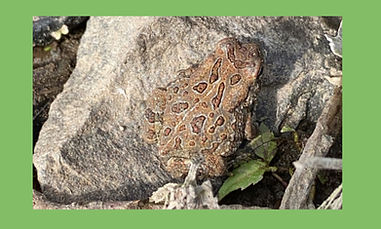Fowler's Toad
Anaxyrus fowleri
Conservation Status:
State Status: Apparently Secure (NatureServe, 2024)
Global Assessment: Least Concern (IUCN, 2021)
Listen to call:
(Benji Beluga, 2018)
Description
Fowler’s toads grow to about three inches long (Watkins-Colwell, 2024). They range in color from gray to tan with darker spots across the back that contain small warts. This species has a white stomach and often a lighter stripe running down the center of the back. Males have darker throats than females.
Habitat
These toads can be found in a variety of
habitats. They prefer sandy soil for burrowing, such as beaches or river valleys. Fowler’s toads can also be found in woodlands, meadows, and urban or suburban yards.
Behavior
Fowler's toads will dig burrows, where they will remain over the winter and during other unfavorable conditions. They will eat small invertebrates, such as insects or arachnids.
Predators may include snakes, birds, and small mammals.When threatened, they often will inflate their bodies to appear larger. If ingested, they will excrete a toxin from the parotoid glands (the oval-shaped bumps located behind each eye) that will cause them to be released (Quinn, 2020).
These toads will breed in the early summer in shallow waters. Males will call out to attract females. Eggs are laid in strings.
Range


Fowler's Toad
Photographed by Riley J
Often Confused with

Eastern American Toad
Photographed by Alyssa Jones
These two species of toads look very similar in appearance. American toads have enlarged warts on their hind legs and dark spots on their underside, while Fowler's toads lack these characteristics. Fowler's toads also tend to have larger groups of smaller warts clustered in the dark spots on their backs when compared to American toads, however this is a less reliable way to tell the two species apart.
References
Benji Beluga. (2018, March 21). Fowler's Toad Calling. YouTube. https://www.youtube.com/watch?v=ZJKXKfqHpdg.
iNaturalist. (2024). Observations. California Academy of the Sciences / National Geographic Society. https://www.inaturalist.org/observations?place_id=49&taxon_id=64977.
International Union for Conservation Of Nature and Natural Resources. (2021, February 16). Fowler's Toad. https://www.iucnredlist.org/species/54640/196333508.
Klemens, M. W. et al. (2021). Conservation of Amphibians and Reptiles in Connecticut. Department of Energy and Environmental Protection. https://ctdeepstore.com/products/conservation-of-amphibians-reptiles-in-connecticut.
NatureServe. (2024, November 1). Anaxyrus fowleri. https://explorer.natureserve.org/Taxon/ELEMENT_GLOBAL.2.102732/Anaxyrus_fowleri.
Quinn, D. P. (2020). Fowler's Toad. Connecticut Herpetology. https://www.ctherpetology.com/fowlers-toad.
Watkins-Colwell, G. J. (2024). Fowler's Toad - Bufo fowleri. Yale Peabody Museum. https://peabody.yale.edu/explore/collections/herpetology/guide-amphibians-reptiles-connecticut.
Watkins-Colwell, G. J. et al. (2006). New Distribution Records for Amphibians and Reptiles in Connecticut, with Notes on the Status of an Introduced Species. Sacred Heart University. https://digitalcommons.sacredheart.edu/cgi/viewcontent.cgi?article=1058&context=bio_fac.
Page updated November 19, 2024
